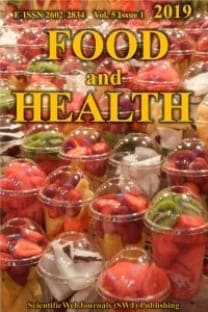INVESTIGATING THE POSSIBILITIES FOR USE OF GRAPE SEED POWDER IN THE PRODUCTION OF CALORIE REDUCED COCOA MUFFINS
___
Altuğ, T., Elmacı, Y. (2005). Gıdalarda duyusal değerlendirme. Meta Basım Matbacılık Hizmetleri. İzmir. ISBN 9944566087Arvanitoyannis, I.S., Ladas, D., Mavromatis, A. (2006). Potential uses and applications of treated wine waste: a review. International Journal of Food Science & Technology, 41(5), 475-487.
Bath, D., Shelke, K., Hoseney, R. (1992). Fat replacers in high-ratio layer cakes. Cereal foods world (USA).
BeMiller,J., Whistler, R., Carbohydrates, F.O. (1996). Food Chemistry: Marcel Dekker. New York. Basel. Hongkong. ISBN-13: 9780824763503
Bozhüyük, A., Özcan, S., Kurdak, H., Akpınar, E., Saatçı, E., Bozdemir, N. (2012). Sağlıklı yaşam biçimi ve aile hekimliği. Turkish Journal of Family Medicine and Primary Care, 6(1), 13-21.
Committee A.A. o. C.C.A.M. (1983). Approved Methods of the American Association of Cereal Chemists (8 ed. Vol. 1): Amer Assn of Cereal Chemists. ISBN-13: 9780913250310
Coşkun, T. (2005). Fonksiyonel besinlerin sağlığımız üzerine etkileri. Çocuk Sağlığı ve Hastalıkları Dergisi, 48(1), 61-84.
Çelik, İ., Kotancılar, H.G. (1995). Kimyasal Kabartıcılar Ve Fırın Ürünlerindeki Fonksiyonları. Atatürk Üniversitesi. Ziraat Fakültesi Dergisi, 26(3), 451-459.
Çelik, T.E. (2012). Enzimatik interesterifikasyon yöntemi ile geliştirilen zeytinyağı bazlı yağ ürünlerinin kek ve bisküvi yapımında kullanılması. (Yüksek Lisans Tezi). Ankara.
Dizlek, H., Özer, M.S., Gül, H. (2008). Keklerin Yapısal Özelliklerinin Belirlenmesinde Kullanılan Ölçütler Paper presented at the Türkiye 10. Gıda Kongresi, Erzurum.
Ekici. L.. Ercoskun. H. (2007). Et ürünlerinde diyet lif kullanımı. Gıda Teknolojileri Elektronik Dergisi, 1, 83- 90.
Kaçar, D. (2010). Kimyasal interestifikasyon yöntemi ile zeytinyağı bazlı yeni bir yağ ürününün geliştirilmesi ve kek-bisküvi üretiminde kullanılabilirliğinin araştırılması. (Yüksek Lisans Tezi). Ankara.
Karaoglu. M.M.. Kotancilar. H.G.. Gercekaslan. K. E. (2008). The effect of par-baking and frozen storage time on the quality of cup cake. International Journal of Food Science and Technology, 43(10), 1778-1785.
Karaoğlu. M.M. (1998). "Farklı yöntemler uygulanarak elde edilmiş modifiye nişastaların kek kalitesi üzerine etkileri". Atatürk Üniversitesi Fen Bilimleri Enstitüsü (Yüksek Lisans Tezi), Erzurum.
López-Miranda, S., Serrano-Martínez, A., HernándezSánchez, P., Guardiola, L., Pérez-Sánchez, H., Fortea. I., Gabaldón JA, Núñez-Delicado. E. (2016). Use of cyclodextrins to recover catechin and epicatechin from red grape pomace. Food Chemistry. 203. 379-385.
Malek, S. (2013). "Kavrulmuş buğday ve arpadan elde edilen unların kek kalitesi üzerine etkisi". Atatürk Üniversitesi Fen Bilimleri Enstitüsü (Yüksek Lisans Tezi). Erzurum.
Martinez-Cervera, S., Salvador, A., Sanz, T. (2014). Comparison of different polyols as total sucrose replacers in muffins: Thermal. rheological. texture and acceptability properties. Food Hydrocolloids. 35. 1-8.
Martinez-Cervera, S., Salvador, A., Sanz, T. (2015). Cellulose ether emulsions as fat replacers in muffins: Rheological. thermal and textural properties. LWTFood Science and Technology, 63(2), 1083-1090.
Meral, R.., Doğan, İ.S. (2009). Fonksiyonel öneme sahip doğal bileşenlerin unlu mamullerin üretiminde kullanımı. Gıda Dergisi, 34(3), 193-198.
Mercan, N., Boyacıoğlu. H., Boyacıoğlu. D. (2000). Kek kalitesi üzerine bazı emülgatörlerin etkilerinin araştırılması. Gıda, 6, 75-81.
Mete, H.E. (2008). Kronik hastalık ve depresyon. Klinik Psikiyatri. 11, 3-18.
Özer, M.S., Dizlek, H., Kola, O., Altan, A. (2004). Değişik Gaz Salınımı Hızlarına Sahip Kabartma Tozlarının Pandispanya Tipi Keklerin Nitelikleri Üzerindeki Etkileri. Gıda, 29(1), 43-50.
Saito, M., Hosoyama, H., Ariga, T., Kataoka, S., Yamaji, N. (1998). Antiulcer activity of grape seed extract and procyanidins. Journal of Agricultural and Food Chemistry, 46(4), 1460-1464.
Seçen, S.M. (2016). Kabak Çekirdeği Yağinin Kek Üretiminde Kullanim Olanaklarinin Araştirilmasi. (Yüksek Lisans Tezi). Nevşehir.
Seyhun, N., Şümnü, G., Şahin, S. (2004). Farklı Nişasta ve Emülgatör Çeşitlerinin ve Yağ Miktarlarının Mikrodalga ile Pişirilen Keklerin Bayatlaması Üzerindeki Etkileri. Gıda, 29(5), 337-343.
Sozer, N., Dalgıc, A.., Kaya, A. (2007). Thermal. textural and cooking properties of spaghetti enriched with resistant starch. Journal of Food Engineering, 81(2), 476-484.
Wang, Z., Zhou, J., Xu, X., Perl, A., Chen, S., Ma, H., (2017). Adoption of table grape cultivars: An attribute preference study on Chinese grape growers. Scientia Horticulturae, 216, 66-75.
Yıldız, Ö. (2010). "Farklı formülasyon. pişirme ve depolama sürelerinin glütensiz kek kalitesi üzerine etkilerinin araştırılması". Van Yüzüncü Yıl Üniversitesi Fen Bilimleri Enstitüsü (Yüksek Lisans Tezi), Van.
- ISSN: 2602-2834
- Yayın Aralığı: 4
- Başlangıç: 2018
- Yayıncı: ScientificWebJournals (SWJ) Özkan Özden
SEVGİN DIBLAN, PINAR KADİROĞLU KELEBEK, LEVENT YURDAER AYDEMİR
CHİA TOHUMU KULLANILARAK ZENGİNLEŞTİRİLEN GALETALARIN BAZI KİMYASAL VE FİZİKSEL ÖZELLİKLERİ
EZGİ ÖZGÖREN, HATİCE BETÜL KAPLAN, SENEM TÜFEKÇİ
THE SUPPLEMENTARY EFFECT OF BLACK AND GREEN TEA INFUSION ON ANTIMICROBIAL ACTIVITIES OF KEFIR
CEM KARAGÖZLÜ, Gülfem ÜNAL, A. Sibel AKALIN, ECEM AKAN, ÖZER KINIK
